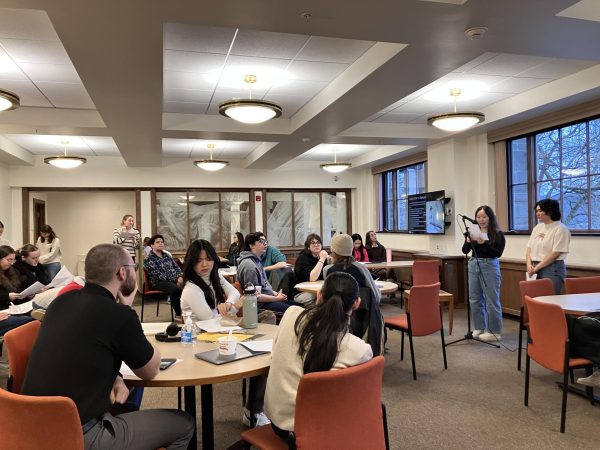Rock Photos, in Concert and Face-to-Face
Photographs in the black and white of silver print form a row that winds its way across the curving walls of the Picker Art Gallery in the exhibition No Sex, No Drugs, Just Rock ‘n’ Roll: The Photography of Barrie Wentzell. Captured in this row of images are the rock musicians photographed by photojournalist Barrie Wentzell for the British music magazine Melody Maker over a career that spanned a vital decade for rock music, from 1965 to 1975. The exhibition is a collection of photographs donated to the Picker Art Gallery by the Rosen Group in 2000. Colgate students put together and curated the exhibition.
Wentzell photographed musicians in all the pomp and motion of the stage and in quieter environs, face-to-face, almost as if interviewed by the camera. In one picture, soul singer Tina Turner stands firm on two famously sturdy legs, flapping her arms and crying out a song. In another, Pink Floyd founder Syd Barrett leans back in a chair, hands raised thoughtfully, his mouth between words, pausing on a thought.
The show’s title, No Sex, No Drugs, Just Rock ‘n’ Roll, was inspired Wentzell’s belief that he had photographed an era when there was an ethic of musicianship that preceded the time when the rock ‘n’ roll was obscured by the sex and drugs. Sex and drugs do make an appearance in the photographs. David Bowie in androgynous costume strikes a charged pose. Jimi Hendrix looms in a daze behind his guitar, lost in a high of song and, most likely, substances. However, more importantly, the poetry of these photographs derives from the poetry of the music.
The photographs also notably depict a kind of celebrity that existed before the super-charged, photoshopped modern celebrity of TMZ and MTV. A photograph of Johnny Cash captures the country singer’s face in plain light with all its crags and wrinkles. A scar runs down his cheek very visibly.
Describing the photography of his day, Wentzell has said, “It was very open. There were no barriers. There were no management hassles, no make-up artists, stylists. People were just as they were.”
Yet, there seems to be more to the story. Ironically, it is a glitzy photograph of singer Diana Ross, all done-up, made-up and lip-glossed that launched this photographer’s career.
The exhibition was organized by a photography seminar of Colgate students that included seniors Alayna Anderson, Ayesha Bhagat, Katherine Downey, Sophie Greene, Leigh Hickey, Chelsea Hoffman, Jenny Kutik and Erin Lushefski, and graduates of the class of 2010 Jeremy Burns, Charlotte Howells, Bryan Kretschmer and Yuxi You.
Students shared their excitement to organize and exhibit the work of a once-unsung photographer.
“He worked in a time when publications didn’t credit photographers. There were no taglines,” Kutik said. “You know the photographs. You don’t know Barrie Wentzell.”
The students were particularly interested in the lived-in quality of the photographs.
“He took incredible photographs of the artists just hanging out,” senior Alayna Anderson said. “He was onstage and backstage with them. An important part of this exhibition was how you relate to the subject as a photographer.”
Yet, as has been said, music photography is ultimately about the music. Onstage or offstage, it finds the spotlight. Look at Aretha Franklin as she emerges out of the almost religious darkness of a blackened stage, hands folded around the microphone as if in prayer. Her music is gospel. Look again at guitarist Ritchie Blackmore descending as he leans into his guitar. His music is rock ‘n’ roll.






